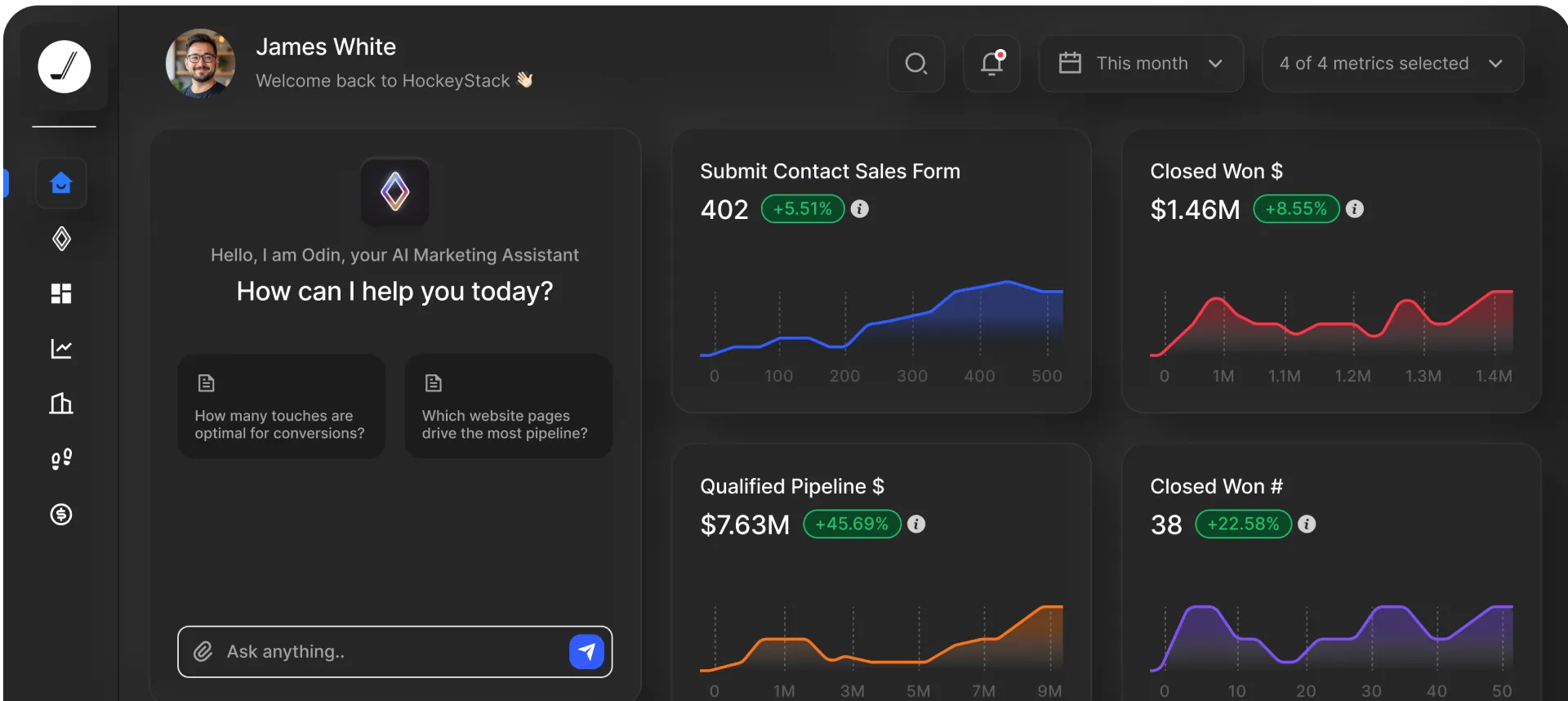AI-Driven Content Marketing Strategies for B2B GTM Teams

AI-Driven Content Marketing Strategies for B2B GTM Teams

You know the feeling. Your team spends a month creating a beautiful, well-researched eBook. You pour hours into the design, the copy, and the promotion. It gets a few dozen downloads, a handful of likes on LinkedIn, and then... crickets. It disappears into the content graveyard with all the others, and when your CEO asks how it impacted the pipeline, you have no real answer.
.webp)
This is the fundamental problem with traditional B2B content marketing: it’s a high-effort, low-visibility guessing game. This isn't just a feeling; it's a measurable problem. According to Content Marketing Institute, while 71% of marketers say content marketing has become more important, less than half feel their organization's content efforts are successful.
This is where an AI-driven content strategy changes the game.
This isn't about just using AI as a writing assistant to create more content, faster. It’s how you shift from just creating content to creating content that reliably generates pipeline and can prove its own ROI.
In this guide, we'll break down the practical strategies for using AI across the entire content lifecycle—from ideation to ROI measurement—and finally give content a seat at the revenue table.
The End of Gut-Feel Content Marketing
To understand the impact of an AI-driven strategy, you first have to be brutally honest about the traditional content marketing workflow. For most B2B teams, it’s a slow, disconnected, and high-effort guessing game with very little visibility into what's actually working.
- Your content calendar is based on a brainstorming session from six months ago, basic keyword research, and what your sales team thinks customers want to hear.
- A single, well-researched blog post or eBook takes weeks of manual effort from multiple people. Repurposing it into other assets is another slow, manual project that rarely gets done.
- You publish the post, share it once on social media, and send it out in a generic, one-size-fits-all newsletter to your entire email list.
- You track vanity metrics like page views, likes, and maybe a few direct downloads. When it comes to proving its impact on revenue, you're stuck with flawed, last-touch attribution that gives all the credit to the "Demo Request" button and makes your content look worthless.
An AI-driven approach doesn't just make the old process faster; it transforms it into an intelligent, connected, and measurable system.
- Your content calendar is based on real data. An AI agent analyzes your historical performance to show you which topics have influenced the most pipeline. It runs automated competitor analysis to find content gaps and uses predictive analytics to spot emerging market trends.
- AI acts as a research assistant and a co-writer, helping you accelerate first drafts and synthesize information. It then helps you instantly repurpose a single pillar asset into a dozen different formats—social posts, email copy, ad creative—in minutes, not weeks.
- Your distribution is hyper-personalized. The AI uses dynamic segmentation to identify high-intent accounts and then helps you deliver the right content to the right person at the right time through automated, tailored email campaigns and other channels.
- You move beyond vanity metrics entirely. A unified GTM AI platform connects every single content asset to the entire customer journey. You can finally see how the blog post a prospect read three months ago influenced the seven-figure deal that just closed, proving the true ROI of your content marketing efforts.
AI-Driven Strategies for the Entire Content Lifecycle
The real power of AI in content marketing isn't just about making individual tasks faster; it's about creating an intelligent, interconnected system that optimizes every stage of how you create, distribute, and measure content.
Here’s a breakdown of actionable strategies you can implement today.
Find Content Ideas That Actually Drive Pipeline
The old way of content planning is a guessing game based on keyword volume and what you think your audience wants. An AI-driven approach is about finding ideas that have a proven connection to revenue.
Analyze Your Own Performance Data First
Your best future content ideas are hidden in your past performance data. An AI can analyze your CRM and web analytics together to find the "golden threads"—the topics, formats, and themes that have historically influenced your most valuable deals. This is the lowest-hanging fruit for your content strategy.
How to get started:
Use a GTM AI platform to connect your CRM and website data. Ask the AI analyst a direct, revenue-focused question like:
- "Which of our blog posts were viewed most often by accounts that became closed-won deals in the last 6 months?"
- "What content formats (e.g., webinars, eBooks, case studies) have the highest influence on enterprise pipeline?"
The answer to these questions is your next content plan. Stop guessing and double down on what already works.
Automate Your Competitor and Market Analysis
Manually checking your competitors' blogs every week is a slow and inefficient way to stay on top of the market. AI can turn this into a continuous, automated intelligence stream.
Use AI tools to monitor the content of your top 3-5 competitors. Set up an automated workflow that alerts you when they publish a new article on a strategic topic or when one of their old posts starts gaining significant new traffic. This allows you to spot gaps in their strategy and create content that provides a better, more comprehensive answer to your shared audience's questions.
💡PRO TIP: Don't just look at what your competitors are writing about; use an AI agent to analyze the comments section of their popular blog posts and the social media conversations around them. This is an unfiltered source of your target audience's pain points and follow-up questions—and a goldmine for your next piece of content.
Learn more → How to Actually Integrate AI into Your Existing GTM Workflows
Mine Sales and Customer Calls for Real Pain Points
Your sales and customer success calls are an unfiltered goldmine of content ideas. Prospects and customers are telling you their exact pain points, objections, and the features they care about most, in their own words. Manually listening to hours of calls is impossible; AI can do it for you.
Use a conversation intelligence tool (like Gong) that uses AI to record and transcribe all your sales calls. Task the AI with identifying recurring themes, common objections, and frequently asked questions. Turn each of those into a piece of content that directly solves a real-world problem for your audience.
💡PRO TIP: Don't just look for topics; look for titles. When the AI surfaces a question like, "How do you handle X compared to Competitor Y?" that's not just a topic idea—that's the exact, high-intent title for your next blog post.
Build a High-Velocity Content Engine
The old way of content creation is slow and linear. A single asset takes weeks, and repurposing it is an afterthought that rarely happens. An AI-driven approach is about creating higher-quality content faster and maximizing the reach of every piece you publish.
Accelerate First Drafts with an AI Co-writer
The goal here isn't to have AI write your entire article. It's about eliminating the "blank page" problem and speeding up the most time-consuming parts of the writing process. AI is a powerful assistant that can handle the initial heavy lifting.
Once you have a data-backed idea, create a detailed outline with your key arguments and talking points. Feed this outline to an AI content creation tool and ask it to generate a first draft. This gives your expert writer a solid foundation to refine, edit, and inject your unique brand voice into, cutting the total creation time in half.
Use AI for Data-Driven SEO Optimization
Modern SEO is about more than just hitting a keyword density. It's about creating comprehensive content that satisfies user intent better than your competitors. AI can provide a data-driven roadmap to achieve this.
Before you write, use an AI-powered SEO tool to analyze the top-ranking articles for your target keyword. The AI will break down the common structure, headings, and semantic keywords used by the top performers. Use this analysis as a creative brief to ensure your content is deeper, more valuable, and structured for organic success.
Instantly Repurpose Your Best Content
The highest-performing teams don't just create content; they amplify it. Manually turning a webinar or blog post into a dozen other assets is a massive time drain. AI can do it in minutes.
How to get started:
Take one of your high-performing pillar assets (like an eBook or webinar recording). Use an AI tool to automatically repurpose it. Ask it to:
- Extract the five most important takeaways for a LinkedIn post.
- Turn the transcript into a detailed blog article.
- Generate a 10-part Twitter thread based on the core concepts.
💡PRO TIP: The most effective AI-powered GTM strategies combine intelligence with amplification. First, use an AI analyst like Odin to identify your highest-performing content based on real revenue impact. Then, use AI creation and repurposing tools to build an entire campaign around that proven winner.

Use AI for Hyper-Personalized Distribution
The old way of content distribution is to blast a generic newsletter to your entire database and hope something sticks. An AI-driven approach is about precision—delivering the right piece of content to the right person at the exact moment they need it.
Identify High-Intent Audiences with AI Segmentation
Effective distribution starts with knowing who to target. Instead of broad, static lists, AI allows you to build dynamic audiences based on real-time intent signals.
Use a GTM AI platform to unify your website, CRM, and product data. Task the AI with creating a dynamic segment of all accounts that match your ICP and have shown high-intent behavior in the last 14 days (e.g., visited the pricing page, started a free trial, or researched a specific feature). This is your priority distribution list.
Automate Personalized Content Delivery
Once you know who to target, AI can help you deliver the most relevant content to them automatically. This moves beyond just personalizing a subject line; it's about personalizing the content itself.
How to get started:
Map your key content assets to different buying signals. For example:
- If an account is researching your competitors, automatically send them your most powerful comparison guide.
- If they just viewed a case study for their industry, send them a follow-up email with another relevant case study.
- This ensures every interaction is contextual and valuable.
Learn more → 13 Ways to Leverage Intent Data for B2B Sales
Optimize Distribution with Channel Analysis
Don't just share content on the channels you think your audience uses; use data to know for sure. AI can analyze where your highest-value customers actually spend their time and engage with content.
Use an AI analyst to examine the entire customer journey of your closed-won deals. Ask it, "Which social media and content channels are most influential for our enterprise customers?" The AI will give you a data-backed answer, showing you whether you should be investing more in your LinkedIn content, email campaigns, or another channel entirely.
💡 PRO TIP: This entire personalized distribution playbook can be automated with GTM workflows. You can build a workflow that automatically identifies a high-intent account, matches it with the most relevant content asset, and triggers a personalized outreach from the right sales rep—all without any manual work. You don’t even have to create them on your own. Explore our library of pre-built GTM workflows.

Measure Content ROI (and Finally Prove Its Value)
The old way of content measurement is to point at a chart of page views and hope the leadership team is impressed. An AI-driven approach is about connecting every single content asset to a closed-won deal and proving its undeniable impact on revenue.
Implement Full-Funnel Content Attribution
You need to move beyond last-click attribution, which gives 100% of the credit to the "demo request" and makes your content look like a cost center. A true AI-powered strategy tracks every single touchpoint across the entire customer journey.
Use a GTM AI platform to connect your website analytics directly to your CRM data. This is the only way to see how the blog post an account read three months ago influenced the seven-figure deal that just closed.
Learn more → The Right Way To Implement Content Marketing Attribution
Analyze Performance by Revenue, Not Vanity Metrics
Stop reporting on likes, shares, and traffic. The only metrics that matter are the ones that translate to revenue. Your AI should be your direct line to these insights.
How to get started:
Task your AI analyst with building a content dashboard that answers these questions:
- "Which content assets have influenced the most pipeline in the last quarter?"
- "What is the average deal size for accounts that have consumed our webinar content?"
- "Show me the ROI for our content marketing spend in Q2."
Identify and Fill Content Gaps in the Buyer's Journey
Your own data can tell you exactly what content you're missing. AI can analyze the content consumption paths of all your closed-won customers to find the gaps.
Ask your AI to analyze the journeys of your most successful customers. It might reveal that your enterprise deals almost always involve a technical whitepaper, or that your fastest-closing deals all engage with a competitor comparison guide. If you don't have those assets, that's your next content priority.
💡PRACTICAL EXAMPLE: Use HockeyStack to build a comprehensive revenue dashboard, just like Airbyte’s revenue strategy dashboard. You can create a single source of truth that tracks every major GTM lever influencing revenue—from pipeline generation and campaign ROI to content engagement—and share it directly with your leadership team. When you can show them a clear, all-in-one view of how your content impacts the bottom line, the conversation about your budget changes completely.
3 Common Mistakes to Avoid (and How to Fix Them)
Adopting AI in your content workflow isn't a guaranteed win. It's easy to fall into a few common traps that lead to creating more content, but not better results.
Here are the three most common mistakes we see B2B GTM teams make.
1. Letting AI Create Soulless, Generic Content
The most common mistake is using AI as a cheap replacement for real expertise and a strong brand voice. Teams get excited about the speed of content creation and start pumping out dozens of generic, robotic-sounding blog posts that are devoid of any real point of view. This content spam provides zero value to a sophisticated reader, and your audience can spot it from a mile away.
🛠️The fix: Use AI as an accelerator, not a replacement for human thought. The best practice is to have your human experts create the core arguments, unique insights, and strategic outline. Then, use AI as a co-writer to generate the first draft, clean up the copy, and handle research. This combines human expertise with machine speed.
2. Focusing Only on Creation, Not on Intelligence
Many teams get so focused on using AI to write that they forget that its biggest superpower is its ability to “think”. They create a high volume of content without first using AI to analyze what topics, formats, and channels are actually influencing revenue. They're just efficiently creating content about things their best customers don't care about.
🛠️The fix: Let intelligence lead your content marketing strategy. Before you create anything, use an AI analyst to analyze your historical GTM data and answer the most important question: "What content has actually influenced our pipeline and closed deals?" Use that data to build your content calendar, ensuring you're investing your resources in topics with a proven connection to revenue.
3. Ignoring Your Data Foundation
Using a powerful AI content tool without connecting it to your own GTM data is like hiring a world-class chef and not letting them into your kitchen. If the AI doesn't have a unified view of your CRM, website, and ad performance, it's just making educated guesses based on generic internet data, not the specific reality of your business.
🛠️The fix: Ensure your AI content strategy is built on a unified data foundation. A true GTM AI platform connects all your disparate data sources first. This allows the AI to generate and personalize content based on what's working for your specific customers and prospects, not based on generic patterns from the rest of the web.
A great content strategy isn't just about creating high-quality articles; it's about proving their impact on the bottom line. Most content teams struggle with this because their tools for creation are completely disconnected from the platforms that track revenue.
The HockeyStack Approach to Revenue-Driven Content
HockeyStack is a GTM AI platform designed to bridge this gap. It’s the central command center that provides the intelligence to guide your content strategy and the attribution to prove its value.
- Find what actually converts. Before you write a single word, our AI Analyst, Odin, analyzes your historical GTM data to show you which topics and content formats have actually influenced your pipeline. Stop guessing what to write about and start creating content with a proven connection to revenue.
- Deliver content to high-intent audiences. Our GTM workflows use dynamic, AI-powered segments to automate the distribution of your content. When a high-intent account is identified, you can automatically deliver the most relevant case study or blog post, ensuring your best content reaches your best prospects at the perfect time.
- Prove your content's ROI. This is where HockeyStack is unmatched. It provides full-funnel revenue attribution for every single content asset. You can finally move beyond vanity metrics and build a dashboard that shows your leadership team exactly how much pipeline and revenue your content marketing efforts are driving.
With HockeyStack, your content team stops being a creative cost center and becomes a predictable, measurable revenue engine.
See it for yourself. Play with our interactive demo now.
FAQs
Will AI replace content marketers?
No, it replaces the most robotic parts of their jobs. AI isn't good at having a unique point of view, understanding brand nuance, or building a strategic narrative. It's a powerful co-pilot that can automate the grunt work—like initial research, drafting outlines, and repurposing content—which frees up human marketers to focus on the high-impact work of strategy and creativity.
How is this different from just using ChatGPT?
ChatGPT is a general-purpose tool that runs on broad internet data. A true GTM AI platform is different because it runs on your specific, unified business data. This means its recommendations and AI content are based on the context of what has actually worked for your business, with your customers. It generates insights based on your reality, not the entire internet.
What's the best first step to get started with AI in content?
The best first step isn't to start creating content; it's to start analyzing it. Before you write anything new, use an AI analyst to connect to your CRM and website data to get a clear, data-backed answer to the question, "Which of our existing content assets have influenced the most revenue?" This gives you a proven baseline to build upon.
Will AI-generated content get penalized by Google?
Google penalizes low-quality, spammy content, regardless of who or what wrote it. It does not penalize content simply for being created with AI. The key is to use AI as a tool to create high-quality, insightful, and well-written content that is genuinely helpful to your audience. As long as your content is valuable, it will perform well in search engine results.
Q2 2025 Product Updates: Nova, Account Plans, Odin, and Marketing Intelligence
HockeyStack just closed its boldest Q2 yet. Solving unique challenges with AI sales, richer analytics, and integrations that drive real GTM impact.


Ready to see HockeyStack in action?
HockeyStack turns all of your online and offline GTM data into visual buyer journeys and dashboards, AI-powered recommendations, and the industry’s best-performing account and lead scoring.

Ready to See HockeyStack in Action?
HockeyStack turns all of your online and offline GTM data into visual buyer journeys and dashboards, AI-powered recommendations, and the industry’s best-performing account and lead scoring.




